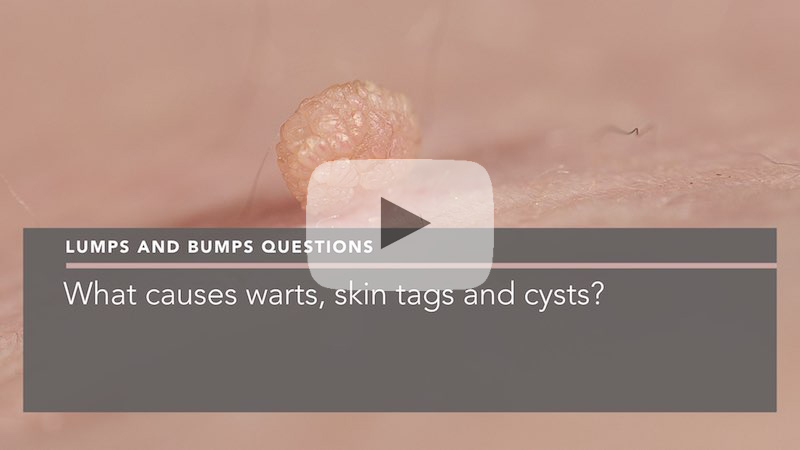Video transcription:
We interviewed Dr Penelope Pratsou to find out the facts about some common lumps and bumps and how they can be treated.
Why do we develop warts skin tags and cysts?
Penelope Pratsou: Firstly, I’d like to reassure anyone with one of these that there’s generally nothing to worry about. Warts, also known as seborrheic warts or seborrheic keratosis, are benign growths on the skin. They can develop on the face, torso, arms and legs, and tend to occur in your 30’s and 40’s. They’re very common. Some people will get them and some won’t. In some patients, there can be quite a lot of them, and sometimes that’s a predisposition which can even run in families.
Warts are essentially extra layers of skin if you like. They can either go totally unnoticed, or they can be itchy and inflamed – In which case, people usually wish to have them treated.
Are seborrheic warts different from viral warts?
Penelope Pratsou: Yes, seborrheic warts are very different from viral warts. Viral warts are, as the name suggests, due to harmless viruses. They tend to be caused by harmless types of the human papillomavirus and we tend to find them more on the hands and feet, but sometimes on other parts of the body and the face. Viral warts tend to affect mostly children and young adults, or people that come into contact with children. However, anyone can develop warts.
What causes skin tags?
Penelope Pratsou: Skin tags are proliferations on the skin in areas like the neck, armpit and groin. They’re usually caused by friction and a bit of moisture. They can also be a predisposition in some individuals who may, for example, experience rubbing between their thighs. Again, these might not cause the individual any bother, or they may be a nuisance and catch on jewellery and clothes. Some people just dislike their appearance.
Where do cysts come from?
Penelope Pratsou: I often see two different kinds of cysts that both look very similar. There are pilar cysts and epidermoid cysts, also known as or sebaceous, keratin, or epithelial cysts. Pilar cysts tend to occur on the scalp, whereas the epidermoid cysts occur more on the body.
These cysts are caused by benign cells in the skin that form the cyst lining. The lining then secretes keratin, the cheesy substance found in the centre of a cyst. If the cyst discharges this material, it can be problematic, especially for people with sebaceous cysts.
A pilar cyst on the scalp on the overhand might not discharge but can become inflamed and red. These cysts can catch on combs and cause other similar problems.
Find out what the best treatments for warts, skin tags and cysts are here.
If you have any of the symptoms or conditions that we’ve just discussed, we invite you to book a consultation with Dr Penelope Pratsou where she’ll be able to assess your condition and give you a suitable treatment plan.

About the author
Dr Penelope Pratsou | Consultant Dermatologist
MBChB, MRCP (UK) (Dermatology)
I’m Dr Penelope Pratsou, a skilled independent Consultant Dermatologist based in Berkshire. I have specialist expertise in the diagnosis and management of all skin cancers, and in performing mole checks. I’m a trained skin surgeon and remove skin cancers, moles, skin tags, cysts and warts.
I also have invaluable experience in dealing with all skin conditions, from the common skin complaints of acne, rosacea, eczema and psoriasis, to the rarer and more complex skin problems, having seen it all through years of NHS work.
After I obtained my Membership to the Royal College of Physicians, I undertook rigorous specialist training in dermatology, before being appointed as a Consultant Dermatologist at the Royal Berkshire Hospital, Reading. There, I helped set up and lead a busy clinic for the diagnosis and treatment of suspected skin cancer. I was also actively involved in supervising and training both dermatology and GP trainees.
Alongside my increasingly busy private practice, I have maintained an NHS practice in Oxford in order to continue to engage with challenging cases and to develop my specialist interest in skin allergy.


